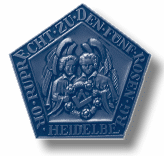|
Over 150 years ago at the founding of the Masonic Lodge in the city of Heidelberg, the model for the Lodge jewel was taken from a masterpiece of Gothic art at the entrance of Ruprecht palace of Heidelberg Castle.
Thus, the name, "Ruprecht zu den Fünf Rosen", was taken from emperor Ruprecht, who was the founder Heidelberg University, the oldest University in Germany.
The entrance leading into Ruprecht palace of Heidelberg Castle received fine workmanship. Which was constucted about 1400; the pointed arch is crowned by a keystone, a masterpiece of Gothic art. It shows two angels on clouds carrying in their hands a wreath containing Five Roses, forming a pentagon, which is a symbol of fundamental strength in a building.
In its center is a slightly opened compass. These figures with their implements are symbols; the mopass symbolizes architecture and refers to the edifice itself, which is under the protection of Saint Mary, also known as Rosary Queen, the Five Roses in the wreath represent the five parts of the Rosary prayer.
The angels represent messengers carrying the prayers of the builders and inhabitants to heaven. The facts are thus based on architecture and its emblematical interpretation.
Legend teaches us that the architect of the Ruprecht palace was a, pious and God fearing artist: His two sons were his very pride and joy. To his great grief, both of the sons died suddenly by falling from the scaffold of the new building where they had been playing. The master very suddenly lost all hope and creative power:
He was brooding in loneliness and no longer had ambition to complete the building.
Every day he went to the graves of his two sons, decorating them with fresh flowers. Emperor Ruprecht the owner of the new palace was very discontent with his lonely and worried builder and had him admonished.
The master replied that he was not able to find a worthy solution for the keystone of the entrance. But one night he dreamed that his two sons were angels descending, carrying a wreath with the Five Roses that he had placed on their tombs the day before.
The next morning while pondering about his dream, he suddenly realized that it was beyond doubt a divine hint for designing the keystone of the portal arch. Soon his dream took shape on his trestle board. The emperor was content, but when he learned that his architect had renounced this world. He had entered monastry on Michael Mountain on the opposite side of the Neckar River.
The keystone crowning the pointed arch is of a symbolic design and conforms to medieval Masonic architecture. The compass represents the old Masonic craft; the Five Roses for the royal art of free masonry and of the good old Lodge Ruprecht of the Five Roses.
On 1 September 1955, The Founding Day of Alt Heidelberg 821, the jewel of R5R was adopted as the official lodge jewel. Since that time Master Masons are required to wear the jewel at all lodge functions. Not wearing the jewel requires a silent contribution to the charity fund.
A very close examination of the castle, should you ever visit it, will reveal that it symbolizes masonry at various points throughout the entire building.
|


|